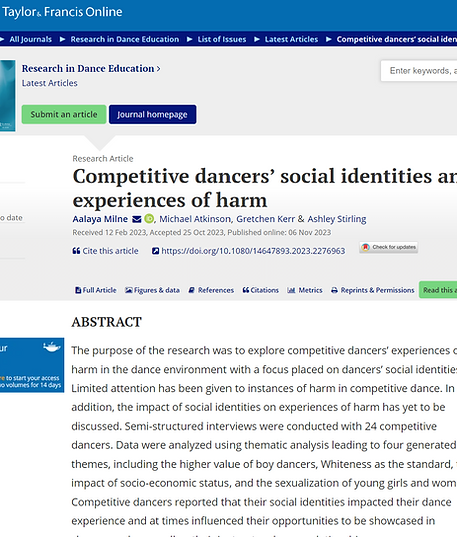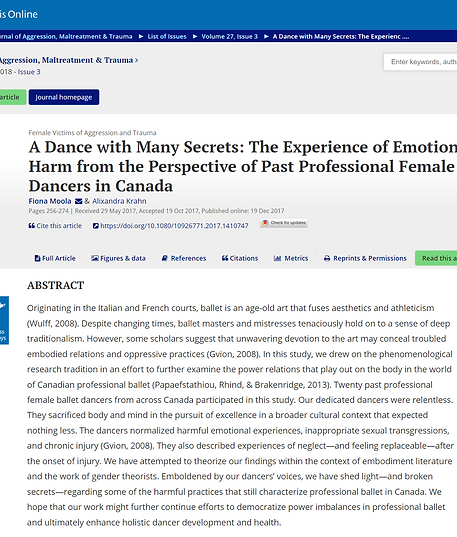Research
Research into personal safety in dance, safeguarding, and abuse prevention is going on all over the world. These studies help shine a light on what is happening in dance and recommendations for how to improve dancers' health and experiences.
While there is a lack of research into abuse in elite dance, numerous allegations of emotional, sexual and physical abuse of dancers can be found anecdotally in the media, legal convictions and personal accounts. As more dancers speak out, the scale of the problem within preprofessional schools and professional companies is becoming apparent. Accordingly, effective safeguarding mechanisms for preventing, identifying and reporting abuse are urgently needed. This viewpoint is intended to raise health professionals’ awareness of factors contributing to abusive practices found in dance environments and the potential clinical implications of abuse to dancers’ health and well-being. We also call for research and policy engagement on safeguarding and abuse prevention designed and implemented in partnership with stakeholders, aiming to promote safe and positive dance environments for all.
The purpose of the research was to explore competitive dancers’ experiences of harm in the dance environment with a focus placed on dancers’ social identities. Limited attention has been given to instances of harm in competitive dance. In addition, the impact of social identities on experiences of harm has yet to be discussed. Semi-structured interviews were conducted with 24 competitive dancers. Data were analyzed using thematic analysis leading to four generated themes, including the higher value of boy dancers, Whiteness as the standard, the impact of socio-economic status, and the sexualization of young girls and women. Competitive dancers reported that their social identities impacted their dance experience and at times influenced their opportunities to be showcased in choreography as well as their instructor-dancer relationship.

Originating in the Italian and French courts, ballet is an age-old art that fuses aesthetics and athleticism (Wulff, 2008). Despite changing times, ballet masters and mistresses tenaciously hold on to a sense of deep traditionalism. However, some scholars suggest that unwavering devotion to the art may conceal troubled embodied relations and oppressive practices (Gvion, 2008). In this study, we drew on the phenomenological research tradition in an effort to further examine the power relations that play out on the body in the world of Canadian professional ballet (Papaefstathiou, Rhind, & Brakenridge, 2013). Twenty past professional female ballet dancers from across Canada participated in this study. Our dedicated dancers were relentless. They sacrificed body and mind in the pursuit of excellence in a broader cultural context that expected nothing less. The dancers normalized harmful emotional experiences, inappropriate sexual transgressions, and chronic injury (Gvion, 2008). They also described experiences of neglect—and feeling replaceable—after the onset of injury. We have attempted to theorize our findings within the context of embodiment literature and the work of gender theorists. Emboldened by our dancers’ voices, we have shed light—and broken secrets—regarding some of the harmful practices that still characterize professional ballet in Canada. We hope that our work might further continue efforts to democratize power imbalances in professional ballet and ultimately enhance holistic dancer development and health.

